|

COOKERY
India
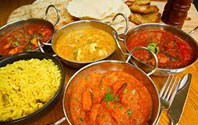
When most people think of Indian food, hot spicy curry is what generally
comes to mind. Indian cooking usually involves a spice or two to cook a
potato dish, for example, and sometimes up to fifteen spices to create
an elaborate dish. But Indian food is not always hot.
The Portuguese introduced chili peppers into Asia in the sixteenth
century. Up until then, the typical pungent Indian spices were mustard
seeds and black peppercorns.
Sometimes the spices are used whole, at other times they are ground and
mixed with water or vinegar to make a paste. Depending on the technique
used, a completely different flavour may be drawn out from the spice.
India also gains variety from the vast number of regional cuisines which
have been adapted to local culinary traditions. Religious and cultural
groups within each region of India have modified these local cuisines to
suit their own restrictions. The influence of the Moghuls should also be
taken into account. They came to India by way of Persia and introduced
the delicate pulaos and meats cooked with fried onions and yoghurt.
Austria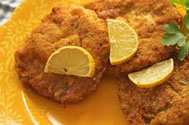
It was in the seventeenth century when Vienna became a great capital
city, and Austrian cooking developed into an art. This was around the
time when the famous Viennese pastry began to be made.
Ideas and food for cooking were imported from all over the continent:
sour cream from the Slavs, paprika from Hungary, pasta and noodle dishes
from Italy. Despite the fact that some of the famous Austrian pastries
and cakes are so extravagant they can only be used for special occasions,
other dishes are highly economical.
Typical Austrian meat dishes, for example, evolved because bulls were
often killed young. They felt it wasteful to keep them and feed them
while they grew up but did no useful work. Cows were put to work and
then killed when they were old and tough, and so the Austrians have
several dishes which use old, tough meat.
The many veal dishes, at which the Viennese are so good at preparing,
grew from the fact that so many baby bulls
were killed.
Sweden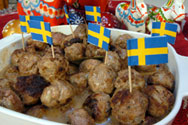
Swedish cooking was heavily influenced in the past by its climate which
limited the supply of fresh food to a few months of the year.
Meals tended to be boring and monotonous, and salted fish or meat and
potatoes were served most of the time.
However, things are very different these days with Swedish smorgasbord
being popular all over the world. The word literally means ‘sandwich
table’, but in actual fact there is a great variety of cold dishes to
choose from.
It wasn’t until the eighteenth century that Swedish cooking developed
under French influence. However, many old traditions persist to this day.
On Christmas Day, ham is traditionally served. On Christmas Eve a plate
of porridge may be put in the attic or cellar for the little gnomes who
are believed to live in the house. The porridge is to thank the gnomes
for their help during the past year and ensure their help in the year to
come.
Belgium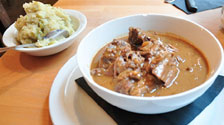
Like the French, the Belgians also have a strong interest in good food.
It is something to be taken very seriously indeed. A Belgian chicken
pate takes time to make, and requires the addition of two glasses of
brandy.
The oldest Belgian national dish is Chicken Waterzoie. It makes for a
hearty country meal and has to be served in extra-large soup plates in
order to hold both the portions of chicken and the vegetables as well.
Another famous Belgian dish is rabbit and prunes. This is complimented
with half a bottle of wine in its preparation, but it is a good dish to
prepare well in advance of the guests arrival.
Indonesia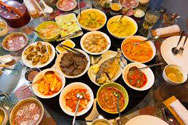
In days gone by it was the Indonesian custom to put all the food on the
table at once and let the guests help themselves. The “help yourself”,
self-service rule still applies but the average family meal now takes
place in a sequence of courses, and the total number of dishes on offer
is now much smaller than it used to be. This is because when the
housewife cooks there is not enough time to make such an elaborate
selection of dishes.
The majority of Indonesians are Moslems and avoid eating pork. They
consider lamb or goat to be their favourite food. The most charming
aspect of eating in Indonesia is the warung, or wayside food stall. It
consists of a roof, a bench and a counter or table. The customers sit on
the bench, or on the ground nearby, and the cooking is done behind the
stall.
Poland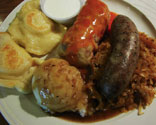
The Polish have always taken a lively and intelligent interest in good
food and the large farming population in Poland has enjoyed a Slavonic
gusto in producing original and tasty dishes from the simplest and
cheapest ingredients.
A variety of soups play a central role in the diet of a Polish family.
They have adopted the Russian borscht and transformed it into their own
national soup.
The basis of borscht is beetroot but no one should entertain the thought
that it is a weak concoction. It is not only nourishing and wholesome,
but has colour and fragrance to make it attractive to the senses.
Polish pastries and cakes are delightful but among the best are the
cheese pastries. For a summer dish of salad, or for picnics, the Polish
way of making a cream cheese spread – combining cream with cottage
cheese together with chopped radishes and cucumber and chives - is
slightly unusual, and very pleasant.
Turkey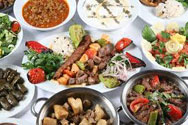
Turkish cooking has a long tradition dating back many centuries to the
Byzantium period. From those early times, the Turks have been grilling
pieces of meat, usually lamb, on skewers. They are also said to have
introduced the rice for their famous pilaffs from Persia.
Of course, like all regional cooking, they make use of their local
vegetables, such as aubergine, courgettes and sweet peppers.
Turks may have a reputation for being a warlike people, but they also
have a sweet tooth. The popularity of Turkish Delight in other European
countries is perhaps a memento of earlier conquests by the Turks who
continue to like extremely sweet delicacies, such as the fragrant and
delightfully delicious rose-petal jam. |


![]()
![]() Before you read a text on cookery around the world, read the following questions.
Before you read a text on cookery around the world, read the following questions.
![]() Now read the text and answer the questions by choosing countries from the drop-down
menu.
Now read the text and answer the questions by choosing countries from the drop-down
menu.










